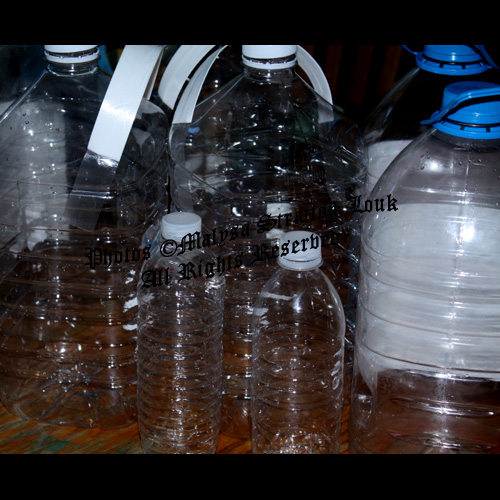Container Gardening for Small Spaces Using Recycled Materials
Use Recycled Water and Soda Bottles to Create an Indoor or Outdoor Garden
Copyright © Malysa Stratton Louk All Rights Reserved. Posted June 3, 2011


Whether you live in a rural area with limited yard space, an apartment complex with no yard or need container planting ideas for the deck, gardening with recycled containers is cost-effective and reduces household waste. It also provides a way to involve kids in gardening in a meaningful way that parents and children can enjoy together.
Materials to use for Container Gardening
- Container: Small and large water bottles, 2 liter soda bottles, juice containers, clean gallon-sized milk jugs, cottage cheese containers and other plastic containers can all be used as planters. Thoroughly clean and dry the containers before use, especially if they were previously used for dairy or fat products.
For milk, water and soda bottles, cut the top off where it tapers so the sides are even. Save the lids for future projects. Using a pair of scissors or a sharp knife cut four or five holes in the bottom to allow for drainage.
- Soil: Purchase a quality, organic potting soil or dig weed-free soil from an inconspicuous area in the yard. Fill the prepared container with potting soil. If you are using soil from the yard, prepare it first by mixing half dirt with half peat moss.
- Water: Tap water is sufficient if the city water is properly treated; however, bottled water and fresh rainwater are the best options, especially for edible plants.
- Compost: Use homemade compost if necessary. You can also add used coffee grounds, tea leaves and crumbled egg shells to the plants. Watch the video, "Composting Made Simple," below for tips on creating simple and effective compost anywhere.
If you have access to enough scraps (from a local grocery or restaurant, perhaps?) you will want to get a larger, professional-grade compost bin.
- Mulch: Mulch is important for many reasons, the two primary ones being water retention and soil amending as it breaks down. Locally harvested hardwood mulch is a good choice. Never use shredded rubber or a dyed product.
Plants for Recycled Containers
Many plants grow well in containers, both indoors and outdoors. Decide the type of garden you want and plant accordingly. Flowers and herbs can often grow together in larger containers. Herbs and many vegetables grow well in containers with proper care.
Gallon-sized water containers and 2-liter soda bottles are great for planting carrots and other root vegetable due to the depth of the containers. Children will enjoy watching these vegetables grow as the roots start to form and fill out.
Other vegetables to consider are tomatoes (especially the small cherry varieties), bush beans, peas, broccoli, pepper plants and salad greens. Nearly all vegetables will grow in containers with proper care; however, the harvest may be much smaller than those grown in a garden bed.
Squashes and melons will also grow in containers due to their trailing nature. Rather than cut the top off the container, secure the lid in place and cut a large hole in the side of the container.
Place the container on its side and plant the squash or melon. When the plants are well established and begin producing, place them in an area where they have room to vine and trail (such as a deck floor or corner of the driveway).
Smaller plastic bottles make great indoor windowsill containers. Use these for herbs or flowers to grow indoors year-round. Unless they are protected from the wind, small containers should not be kept outdoors.
Composting Made Simple: Create a Backyard Compost Pile
Articles Others are Reading:
- Best Fruit Tree Choices for the Texas Gulf Coast and the Southern US
- Soil Preparation for a Raised Bed Vegetable Garden
- Organic Foliar Feeding with Garrett Juice
- Organic Foliar Feeding with Garrett Juice
Website © 2011 KSmith Media, LLC; all Rights Reserved.